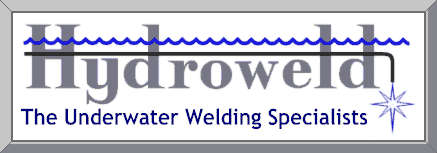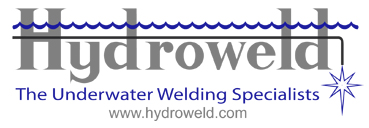
Surface quality wet welding
'A' Class above the rest
Wet welding has always been seen as the poor relation to conventional
dry, surface welding but should this really the case? The wet welding process is the most
widely used method for welding underwater, its versatility and cost effectiveness can
provide a viable and desirable alternative to the more traditional methods of repairs to
underwater structures such as dry docking, habitat welding or clamping. Wet welding
systems can be mobilised in hours rather than days and repairs can often be completed
whistle structures or vessels are still in service.
As an aid in providing quality assurance the American Welding Society (AWS) developed a
welding standard, the AWS D3.6 Specification for Underwater Welding. This specification,
which was first published in 1983, was intended to provide those with a requirement for
underwater welding a choice of weld quality, on a fitness for purpose basis, taking in to
consideration the state of the art of underwater welding at that time, and included both
dry hyperbaric and wet welding. The specification has subsequently been revised several
times but still sets out four classes of welds identified as class A, B, C or O. These
classes are broadly defined as: class 'A' welds which are intended to be comparable with
above water welds by virtue of specifying comparable properties and testing requirements.
Class 'B' welds which are intended for less critical applications where lower ductility,
greater porosity and larger discontinuities can be tolerated. Class 'C' welds which are
intended for applications where load bearing is not a primary consideration and satisfy
lesser requirements than class A, B and O. And finally class 'O' welds which must also
meet the requirements of another code or specification.
In recent years the wet welding process has seen dramatic improvements in weld quality
which has broadened its potential to encompass underwater welding projects for which it
previously could not be considered. With the advent of new wet welding electrodes (Hydroweld
FS) and the development of new wet welding techniques combined with modern welding
power sources and equipment the process can now provide weld quality comparable to that
expected on the surface. Whilst class 'B' and 'C' welds are easily achieved with the wet
welding process, the production of class 'A' welds has not, until recently, been an option
because of the difficulties in meeting the all of the mechanical and visual property
requirements detailed in the specification.
|
 |
| |
|
Historically wet welds have lacked ductility, have high hardness
values, suffered from hydrogen cracking and suffered from brittleness. Some manufactures
of wet welding electrode often quote-individual properties of their electrodes as being
class 'A' acceptable such as a radiography report or tensile strength but are still a long
way from meeting class 'A' weld specification. Lack of ductility is still one of the major
faults with many electrode manufactures quoting less that 9% elongation on all weld metal
tensile tests and impact tests well below what is required by class 'A'.
 |
|
| |
|
In September 1999 a group of enterprising diving contractors joined
forces and embarked on an ambitious wet welding programme, which proved to be an historic
first. The programme included an intensive wet welder-training programme, the production
of welding procedures and finally the completion welder qualifications. But unlike
anything before, this programme was aimed at pushing the boundaries of wet welding
technology one step further. The aim was to become the first diving contractors in the
underwater ship repair industry to offer 'surface quality, structural wet welds' as
specified in the AWS D3.6M: 1999 Specification for Underwater Welding for Class 'A'
welds. Thus producing a weld quality, which should be acceptable as permanent wet
welded repair method within the shipping industry.
The principal companies involved were Miami Diver inc. (USA), Trident BV
(Netherlands) and Cores Diving (Canada). Dedicated to providing a quality
service within the ship repair industry, these companies consistently strive to be leaders
in their field. As part of there ongoing self-imposed strive for excellence they employed
the services of Hydroweld (UK) a company who is recognised internationally as
leaders in the field of wet welding, to provide them with the wet welding technology
required to fulfil their goals.
It was Hydroweld's reputation that convinced Kevin Peters of Miami Diver Inc. that if they
were going to succeed they needed the expertise that Hydroweld had to offer. Hydroweld
wrote the formal Wet Welding Procedure Specification (WPS) which included the use of
Hydroweld FS wet welding electrodes and put together an intense wet welder-training
programme.
Then finally assisted in the qualification of the welding procedures and welder
qualifications.
| |
 |
|
|
The project was completed at Miami Diver Inc. underwater training
facilities in Miami, Florida where a confident Kevin Peters, on completion of the 10 day
training programme, made arrangements for six of the major classifications societies to
attend and witness the welding procedures, welder qualifications and testing of the
coupons.
These independent witnesses including Lloyds Register of Shipping (LRS), American Bureau
of Shipping (ABS), Det Norske Veritas (DNV), Bureau Veritas (BV), Rina and Germanisher
Lloyd (GL). Their attendance was required to ensure the welding procedures, welder
qualifications and testing of the coupons complied with the AWS D3.6M-99 Specification for
Underwater Welding Class 'A' weld standard. Kevin Peters also arranged for an
independent accredited test house to complete the sophisticated testing of the coupons.
The test house provided the data from the testing and together, with the classification
societies, confirmed that the specimens complied with or exceeded the requirements of the
AWS D3.6M: 99 for Class A welds.
 |
|
|
|
The welding procedure coupons were completed in three positions 2F
Horizontal (PB), 3F Vertical (PG) and 4F overhead (PD) positions. In addition a 20 mm
Grove/Butt weld (for the Charpy impact test and all weld metal tensile test) and a
longitudinal fillet weld -shear strength test specimen was produced in accordance with the
specification. The welder qualifications were completed in the 3F vertical and 4F overhead
positions.
Kevin Peters of Miami Diver acknowledges that the Hydroweld
FS wet welding
electrode was crucial to the success of the project ' Other wet welding electrodes lack
ductility, one of the biggest obstacles in qualifying class 'A' welds is meeting the
requirements of the all weld metal tensile test. Most weld welding electrode can only
manage 6% - 9% elongation, the specification requires a minimum of 14% the results from
Hydroweld FS gave us 17% which is comparable to surface welds. All of the other testing either
met or exceeded the requirements of class 'A' welds including the visual, macro
examination, hardness, fillet weld shear, and Charpy tests.
The successful completion of the welding procedures and welder qualifications to the AWS
D3.6M: 99 Class A welds proves that surface quality wet welding can be achieved.
This represents a significant step forward and one that may result in wet welded repairs
in the merchant shipping industry being accepted as permanent.
Hydroweld offer speciality welding services to the industry throughout the
world and strive to improve the reputation of wet welding which has
historically been misused and applied.
|






